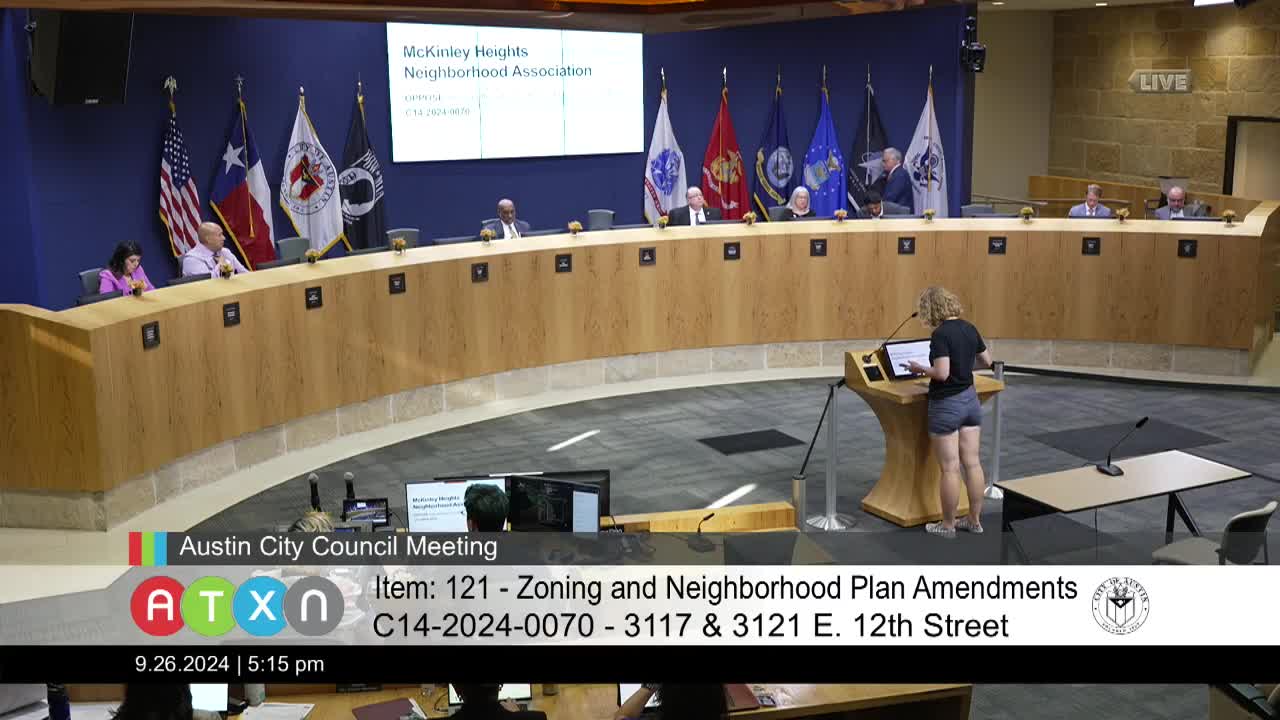Community fights back against controversial zoning change proposal
September 26, 2024 | Austin, Travis County, Texas
This article was created by AI summarizing key points discussed. AI makes mistakes, so for full details and context, please refer to the video of the full meeting. Please report any errors so we can fix them. Report an error »

During a recent city council meeting, significant concerns were raised regarding a proposed zoning change on Thornton Road, which aims to allow the construction of a 350-unit multifamily residential building. Residents and community members voiced strong opposition, citing traffic congestion, inadequate infrastructure, and the potential negative impact on the neighborhood's character.
Speakers highlighted that Thornton Road is already experiencing heavy traffic, exacerbated by its narrow width and the presence of an at-grade railroad crossing. Many residents argued that the proposed development would increase daily vehicle trips by approximately 1,400, leading to further gridlock and safety issues. They emphasized that the street is not equipped to handle such an influx of traffic, with limited exit routes and insufficient sidewalks for pedestrians.
Community members expressed frustration over the lack of meaningful engagement from the developer, stating that their requests for traffic studies and infrastructure improvements had been largely ignored. They called for a more appropriate scale of development, suggesting that zoning for fewer units, such as MF2 or MF3, would better align with the existing neighborhood density and infrastructure capabilities.
The applicant's representative defended the proposal, arguing that the shift to residential zoning would reduce the intensity of use compared to the current commercial zoning, which allows for more disruptive businesses. They also noted that the project would maintain a height limit of 60 feet and reduce impervious cover, addressing some community concerns.
Despite the applicant's assurances, council members acknowledged the community's apprehensions and the need for further discussions. The council ultimately decided to approve the zoning change on first reading only, allowing for additional dialogue and potential adjustments to the proposal in response to community feedback.
As the meeting concluded, residents were encouraged to remain engaged in the process, emphasizing the importance of their voices in shaping the future of their neighborhood. The council's decision reflects a growing recognition of the need for balancing development with community needs and infrastructure capacity.
Speakers highlighted that Thornton Road is already experiencing heavy traffic, exacerbated by its narrow width and the presence of an at-grade railroad crossing. Many residents argued that the proposed development would increase daily vehicle trips by approximately 1,400, leading to further gridlock and safety issues. They emphasized that the street is not equipped to handle such an influx of traffic, with limited exit routes and insufficient sidewalks for pedestrians.
Community members expressed frustration over the lack of meaningful engagement from the developer, stating that their requests for traffic studies and infrastructure improvements had been largely ignored. They called for a more appropriate scale of development, suggesting that zoning for fewer units, such as MF2 or MF3, would better align with the existing neighborhood density and infrastructure capabilities.
The applicant's representative defended the proposal, arguing that the shift to residential zoning would reduce the intensity of use compared to the current commercial zoning, which allows for more disruptive businesses. They also noted that the project would maintain a height limit of 60 feet and reduce impervious cover, addressing some community concerns.
Despite the applicant's assurances, council members acknowledged the community's apprehensions and the need for further discussions. The council ultimately decided to approve the zoning change on first reading only, allowing for additional dialogue and potential adjustments to the proposal in response to community feedback.
As the meeting concluded, residents were encouraged to remain engaged in the process, emphasizing the importance of their voices in shaping the future of their neighborhood. The council's decision reflects a growing recognition of the need for balancing development with community needs and infrastructure capacity.
View full meeting
This article is based on a recent meeting—watch the full video and explore the complete transcript for deeper insights into the discussion.
View full meeting
